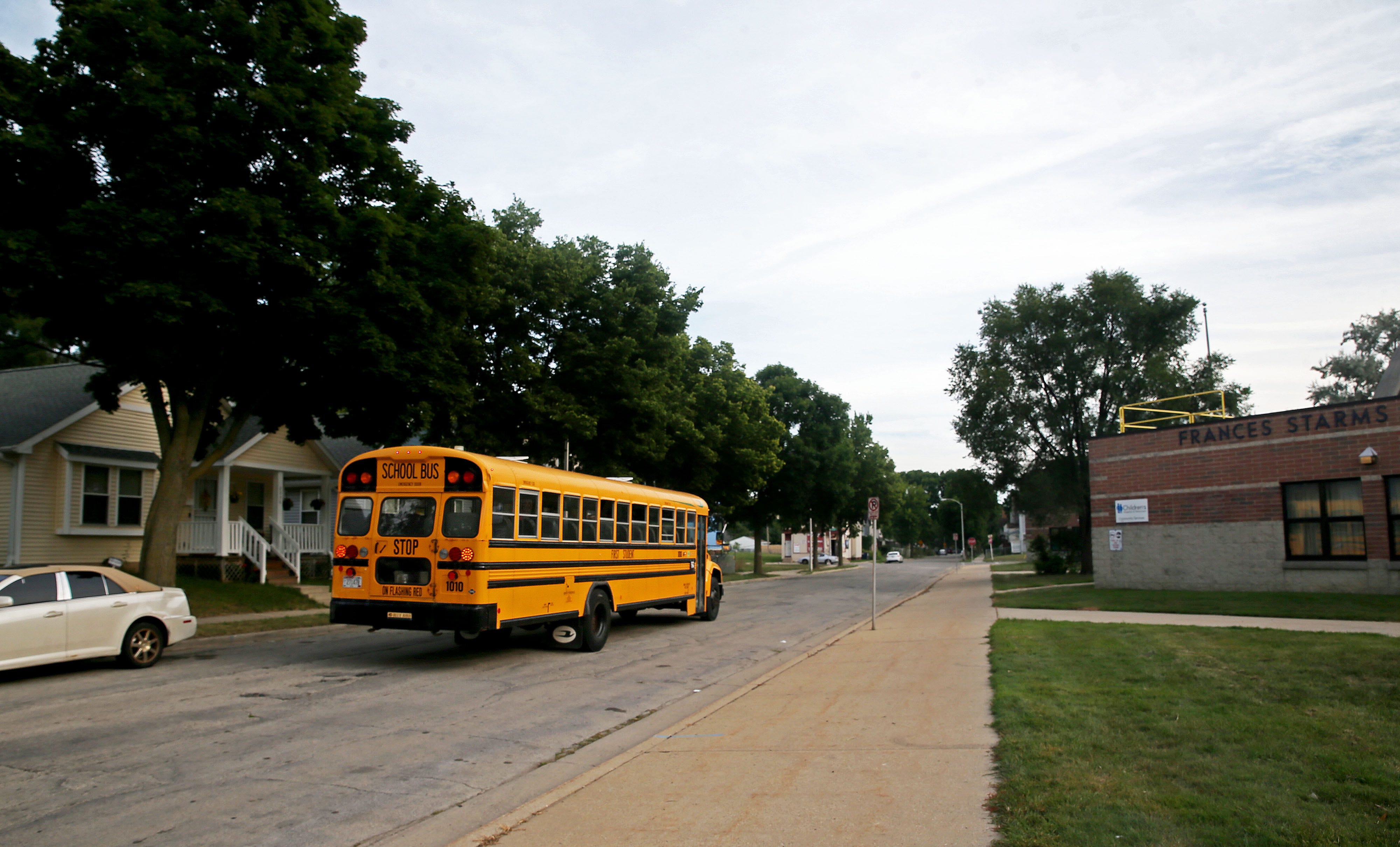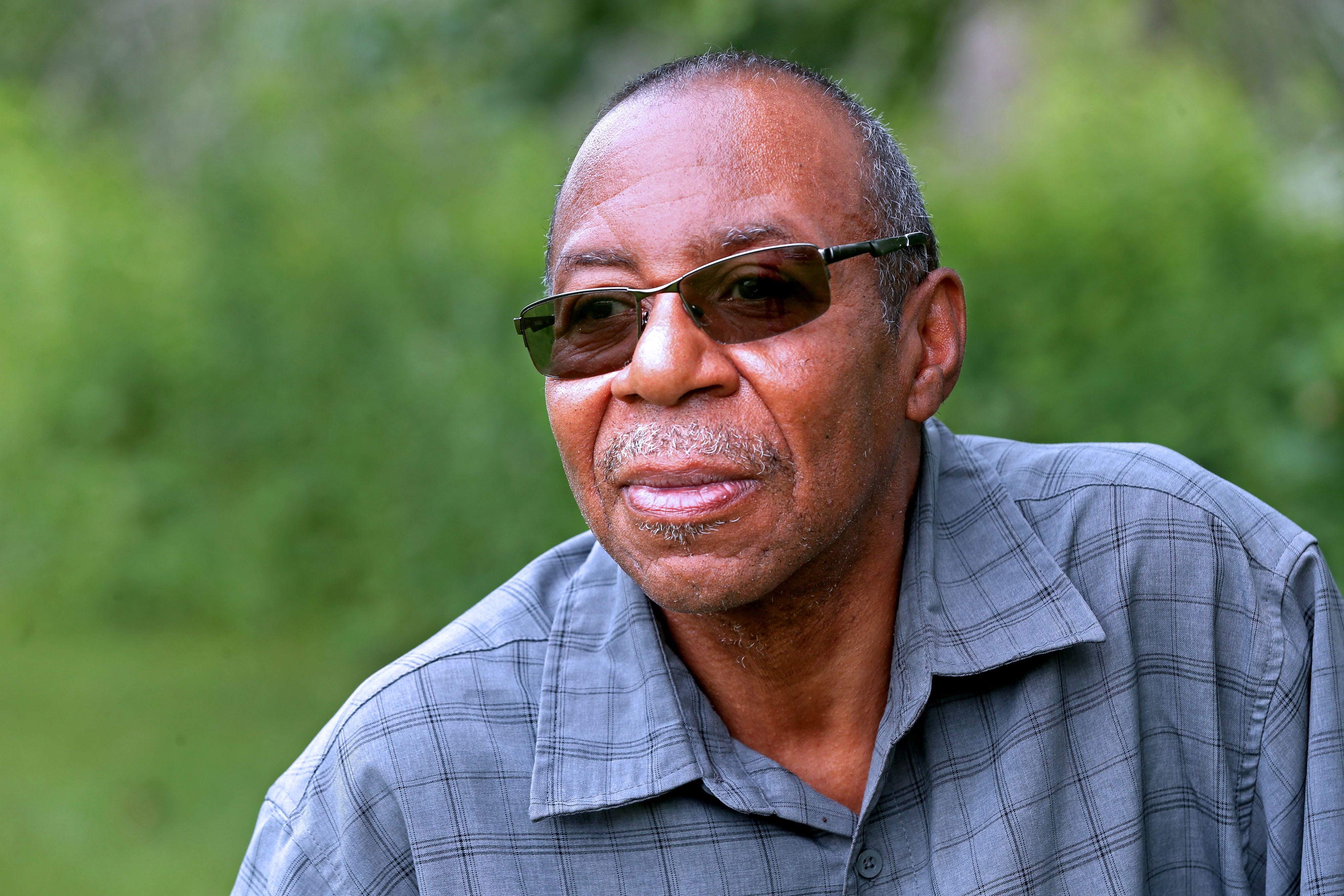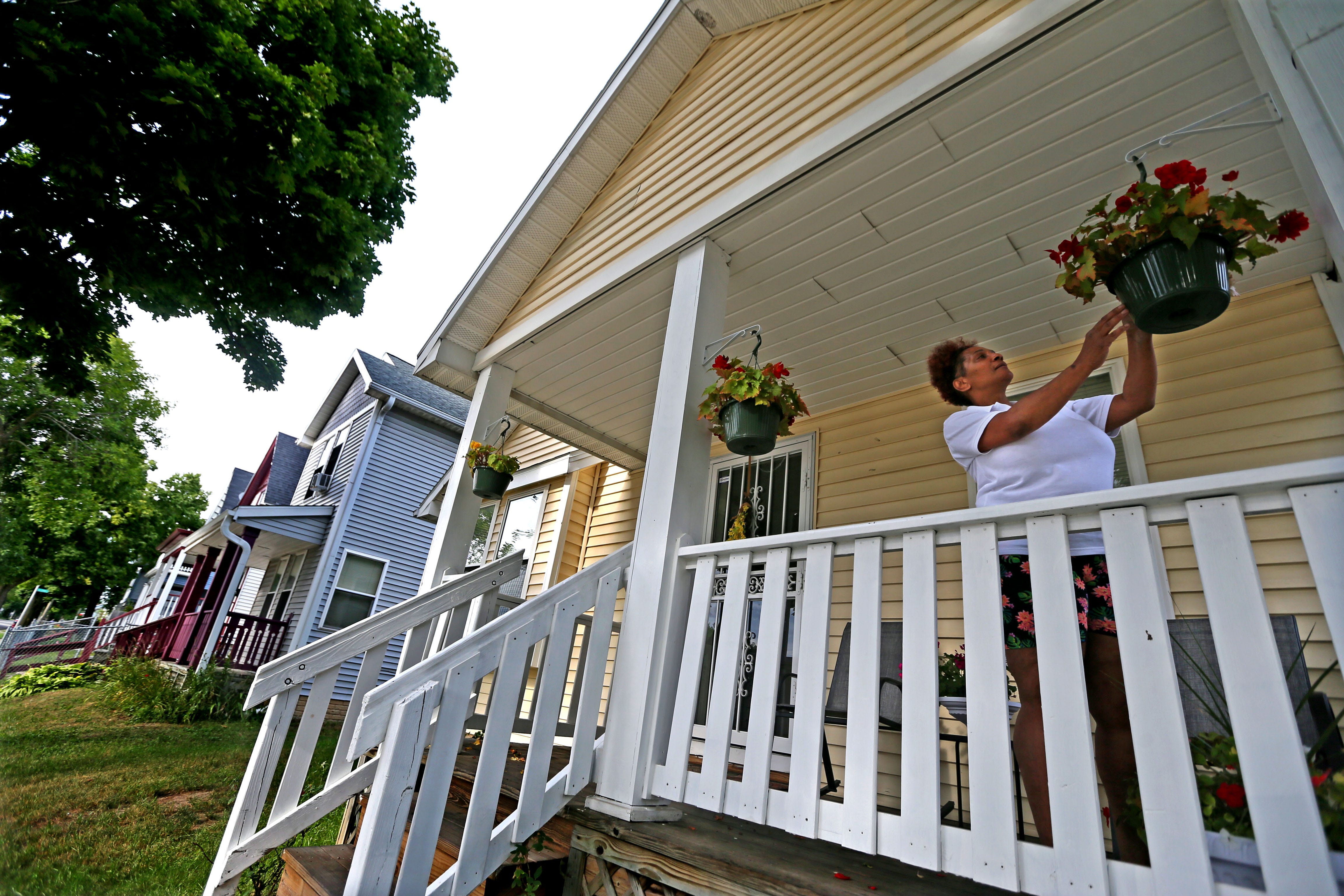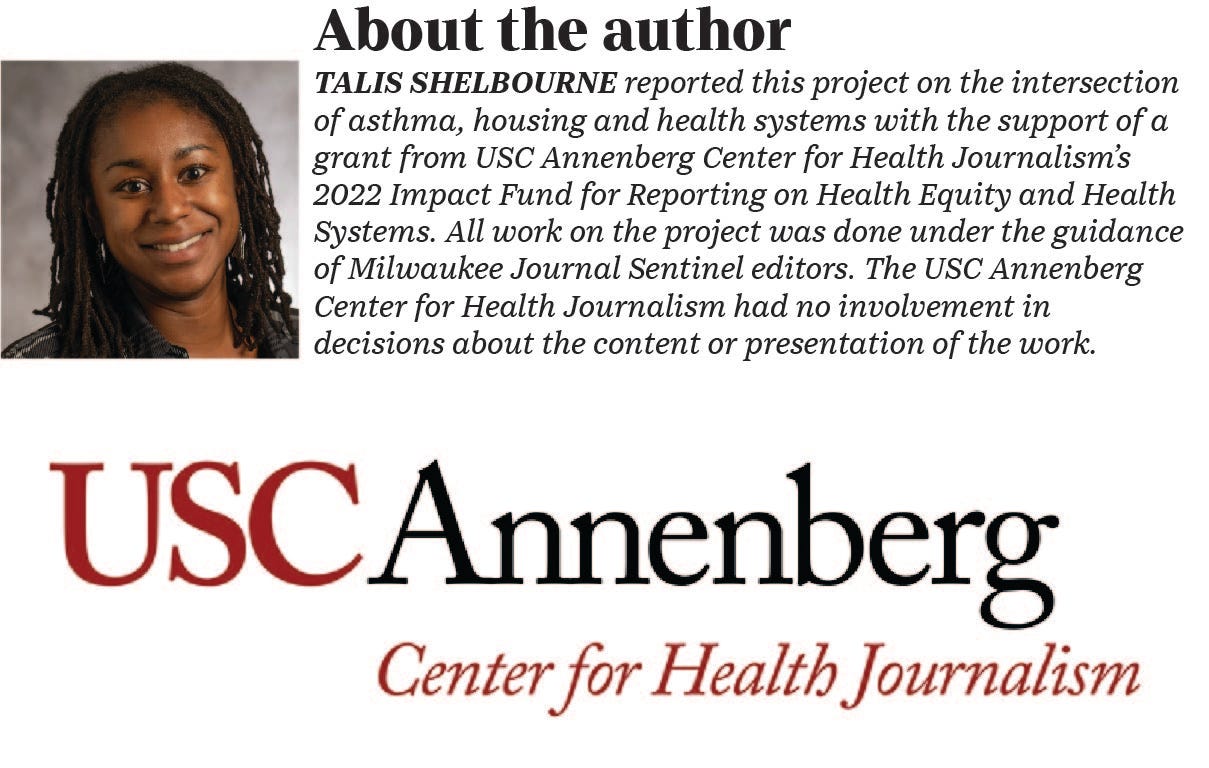
Starms Discovery Learning Center school nurse Ashley Capodarco exams student Major Wilson, 9, in her office. Asthma is the most common disease Capodarco sees at the school. Angela Peterson / Milwaukee Journal Sentinel
When Ma’Siah was born, Monica Farr loved watching him. She adored the sounds her son made as he stretched his tiny hands toward her, the way his cheeks would puff before breaking into a smile when she picked him up to nurse him.
But one day, those cheeks started to turn blue. Panic flooded Farr’s body as her baby struggled to breathe. She rushed him to an emergency department, where doctors stabilized him.

It was not his first health crisis.
At three months, Ma’Siah had surgery for laryngomalacia, a condition where the tissues above the vocal cords are too soft and flop in the airway, making it harder to breathe.
Farr thought that would be the end of his breathing problems.
But as he grew older, Ma’Siah suffered more and more crises. After he turned 3 years old, doctors suspected he was severely asthmatic, but because of his age, they waited to confirm the diagnosis.
Farr was terrified to sleep, fearing she wouldn’t be available if he began having breathing problems. She watched Ma'Siah to catch the slightest hitch in his breath or wheeze from his chest. On the way home from each emergency department visit, she worried about when the next would come.
After having four healthy children, Farr’s focus on her son’s challenges brought an element of trepidation into the family.
Ma’Siah’s asthma was uncontrolled. And when Farr watched him, her feelings went from joy to helplessness.
Income, housing, race intertwined
Farr’s angst would be familiar to parents and caregivers of the 6 million asthmatic children in the United States. The chronic respiratory condition, which afflicts 25 million people overall, disrupts breathing and prevents oxygen from reaching vital organs. A severe attack can be fatal; on average, 11 people die from an attack every day.
Uncontrolled pediatric asthma consistently ranks within the top three causes of emergency department visits in Milwaukee.
As with so many other health care issues, poverty complicates and intensifies the challenges of asthma management. Poor families living in substandard housing are more likely to be exposed to asthma triggers, such as mold, dust mites, cockroaches and mice. Children with uncontrolled asthma often dwell in the city’s most impoverished and under-resourced neighborhoods.
Further, asthma management doesn’t happen in a vacuum. Low-income parents may need to leave work to address a child’s attack. If that time off multiplies, it can lead to less income, even lost employment. Further, children who miss school may fall behind academically or miss out on social activities. And poorly controlled asthma in youths can lead to even worse respiratory diseases in adulthood, including permanent lung damage.
Much of this has a racial component as well, magnified in a majority-minority city that ranks second in poverty among the 50 largest cities in the United States, according to U.S. Census Bureau data.
Children who live in 53205, a predominately Black ZIP code on Milwaukee’s near north side, visit the emergency department for asthma 20 times more than children living just a 15-minute drive away in the predominately white suburb of Whitefish Bay, Wisconsin Hospital Association data shows.
Milwaukee ranked fourth among the nation's top 20 “asthma capitals” based on estimated asthma prevalence, emergency department visits due to asthma, and asthma-related fatalities, according to a 2021 report by the Asthma and Allergy Foundation of America.
Beyond just the city, the rate of Black children visiting emergency departments for pediatric asthma in Milwaukee County was higher than the combined rates of Asian, Hispanic and white children. And statewide, the asthma death rate for Black patients in 2020 was five times that of white patients.
But the ubiquity of asthma means that uncontrolled asthma is often overlooked as a potentially disruptive and debilitating disease, leading to a lack of resources being channeled to address it.
Health clinics are only now beginning to explore how the social determinants of health — housing, income, education — undermine the care asthmatic children receive in emergency departments and urgent care centers. Local nonprofits, such as Fight Asthma Milwaukee Allies, do what they can to improve asthma outcomes but tend to be underfunded. Health systems, community health centers and the city don't have enough community health workers to help low-income families learn how to manage asthma triggers and improve health literacy.
‘You have to lose pay to get care’
Ashley Capodarco is a school nurse at Starms Discovery Learning Center.
When someone suffers an asthma attack, it’s Capodarco’s job to provide the child's inhaler. If one isn’t available, she tries to reach someone on the child's contact list to bring an inhaler, or take the child to urgent care. If the child’s guardians don’t respond, Capodarco calls for an ambulance as a last resort.
When she reaches parents, Capodarco said they regularly tell her: “'I’m at work. What am I supposed to do?' I just offer empathy and offer to write them a letter on official letterhead. But often, they have to deal with the consequences of coming to get their kid. It’s a resource strain and costs the family money. You have to take off work, (and) you have to lose pay to get care.”

Asthma is the most common disease Capodarco sees at Starms, an elementary and middle school located in the 53205 ZIP code. The student body is more than 90% Black. Reading and math scores are low, so missing school time is particularly detrimental.
Glory Tutaj is a former school nurse who now works as a health practitioner mentoring school nurses at nearly a dozen locations, including Starms.
“I've seen kids whose asthma is so uncontrolled that the parent is picking them up every week to take them to their emergency room, and on the verge of losing their job because of it,” she said.
Missed workdays, and the fear of a potential asthma attack, prompt some families to keep their asthmatic child — or all their children — at home, leading to increased rates of absenteeism.
“I was with a nurse this week, and she was following up with a family,” Tutaj recalled. “And the mom said, ‘Oh, I kept all my kids home today because so-and-so has asthma and with the cold, I knew they’d have an asthma attack.’ So, it’s not even when they’re just having symptoms.”
The Childhood Asthma Leadership Coalition estimates pediatric asthma causes 7.2 million missed school days per year. A 2017 study estimated that each time an asthmatic child has an attack, the child loses three to five school days and the child’s parents lose the same number of workdays.
All that doesn’t account for the concept of “presenteeism.”
The term is used to describe children who do not suffer acute enough symptoms to visit the emergency department, but still struggle to focus in school because their asthma is constantly being triggered. That inability to function is often compounded by sleep deprivation because asthma tends to flare up at night.
Most frustrating to health and school officials, uncontrolled asthma is preventable. By some estimates, improving its management could save a quarter of the roughly $6 billion annual direct cost of pediatric asthma in the United States.
'Triggers' thrive in inadequate housing
Asthma is a two-pronged disease. Patients have inflamed airways prone to being hyperactive, and the airways spasm in response to a patient’s sensitivities to certain triggers, such as dust, pests and pets. That leads to what is known as an asthma “attack.” Managing asthma often requires two medications: a controller taken daily to calm the airways and a rescue inhaler used when those airways begin to spasm in response to a trigger.
When Tamika Glenn worked as an asthma specialist for the Milwaukee nonprofit Community Advocates, she saw plenty of housing-related asthma triggers. “I would say mice and roach problems were very heavy," she said. "With a lot of the animals, dogs and cats, there was pet dander. Older adults definitely had mold in their house.”
Glenn also said landlords were slow to respond to complaints and requests for repairs in the low-income communities where she worked.
Dr. Emmanuel Ngui, an associate professor at the University of Wisconsin-Milwaukee Joseph J. Zilber School of Public Health, said the highest rates of asthma tend to cluster in counties with significant low-income and minority populations, such as Milwaukee, Menominee and Racine.
The 53205 ZIP code in Milwaukee, where the median income of families is less than $25,000 and nearly one-third of families with children live below the poverty line, is a prime example.

"If you can afford good housing, you will not live in (a) house with asthma triggers, such as smoke, mold, mildew, cockroaches and rodents,” Ngui said. You also would live away from highways, Ngui said, where the particulate matter of cars and summer heat combine to make it harder for anyone in the community to breathe — "so, you can imagine if you have asthma.”
Managing asthma while being transient or homeless makes the problems worse, said Kevin Izard, a Milwaukee physician and former Cream City Medical Society president.
For example, to reduce the presence of dust mites, he would recommend a family change their child’s bedsheets often and use hypoallergenic bedding. “But a lot of times, you’re talking about people who don’t have a bed to sleep in,” he said.
Moving constantly also makes keeping up with asthma medications difficult. “If you’re moving every other month and getting evicted or staying with other people, things happen in the process, and you lose your inhaler,” he said.
Lack of access; distrust of 'the system'
One big factor in managing asthma is avoiding lung irritants such as secondhand smoke. Again, poverty and race are factors.
Black smoking rates are almost identical to white rates, according to the American Lung Association, but the overwhelming choice among Black smokers is menthol cigarettes. For decades, tobacco companies targeted communities of color with ads featuring menthol-flavored cigarettes.
“We know that menthol additives make it easier to start and harder to quit,” said Edgar Mendez, a member of the Wisconsin Tobacco Prevention and Poverty Network.
When trying to educate families about potential asthma triggers like smoking or persuade them to take their child to see a doctor, Capodarco sometimes breaks through.
But all too often, she hits a wall.

“There’s definitely a cultural barrier, a lot of distrust based on race,” she said. “It is tough when you’re trying to speak to a parent advocating as hard as you can, as politely as you can, (telling them) ‘Please, you need to take a child in,’ and they just don’t believe it."
Capodarco said many people in the neighborhoods around Starms distrust medical providers with what she described as a “defensiveness against the ‘system.’” As a result, many parents often manage their children’s asthma in the same way their parents managed their asthma.
Even after an asthma attack, some parents tell Capodarco that their child is not sick and just needs water or a nap. “I see a lot of health miscommunication on what’s serious, what’s not serious,” Capodarco said. “What that leads to is the only time they’re going to take them in, is when they’re so sick, they need to be hospitalized and treated a little more seriously.”
It’s a pervasive “buck up” mentality Capodarco recalls from her own childhood. “I didn’t have a lot of money growing up. I wasn’t in deep poverty, but my parents did the exact same stuff."
Getting to the doctor is often a challenge for practical reasons as well.
Single parents who have multiple children struggle to make doctor appointments if they lack a car. And parents working low-wage jobs don’t have the luxury of leaving work for hours when a doctor’s office is only open during business hours. Pulmonologists, who focus on the lungs and often specialize in asthma, can be particularly tough to see.
As a result, some parents make a habit of using the emergency room to temporarily alleviate their child’s asthma attacks, rather than primary care visits to prevent them. Capodarco said she recalls that trend from her time working in an emergency department, where she saw many patients who would not have needed to come in if they had been able to access preventative care.
“I can’t 100 percent tell you why, but I have had people from the neighborhood tell me — grown people — that (the emergency department) is the place to go. Their parents never took them to a primary care physician. I don’t know if it’s because they can’t deny you,” she mused. “It’s a cultural thing where it feels more appropriate to go to the emergency room for help.”
According to the medical standard of asthma treatment, the National Asthma Education and Prevention Program, there are four components of asthma management: “Assessment and monitoring of the level of asthma control to adjust a patient’s management plan accordingly; education to improve self-management skills of patients and their families; pharmacologic treatment; and (the) reduction of environmental triggers that worsen asthma.”
Gary Steven, director of the Allergy, Asthma and Sinus Center, said there’s a hierarchy to those components.
“Medications and even biologics are there to treat inflammation and bring it under control,” he explained. “The holy grail is eliminating the inflammation to begin with. If we can address the root of the problem, eliminate the rodent and cockroach infestations, that’s a much better road to go.”
However, many families don’t even know their child’s asthma triggers because they never undergo allergy or lung testing (also called spirometry), which Steven says is essential to any asthma management program. Without it, Steven said, it’s like trying to treat hypertension without knowing someone’s blood pressure or manage a diabetic without knowing their blood sugar.
This divide between what parents should do versus what they actually do crystallized for nurse practitioner Tutaj when she spoke to a mom relying heavily on the emergency department to manage her child’s asthma.

“She was missing work," Tutaj recalled, "And it wasn’t good, and … we kind of had this heartfelt moment and I was like, ‘You know, I really don't want to call you about your kid and my goal is to never have to call you again. We want your kid to be here and healthy.’ (And her) realizing ‘Oh, if I could get my kid that preventative care, maybe I wouldn't have to pick them up.’ In that moment, it was like it clicked. And after that, there was a huge difference for them.”
Finding an advocate
The tendency to treat asthma on a crisis-to-crisis basis often means health care providers are being asked to deal with the complexity of a low-income asthma patient’s life with just a brief visit and a prescription pad.
For Dorian James, former coordinator of Community Health Asthma Management Program (CHAMP) at Children’s Wisconsin, that’s an inadequate toolkit.

James has been building his expertise in asthma management since 1998, when he worked at an asthma clinic for St. Joseph Hospital (now known as Ascension – St. Joseph) until 2006. After several years of consulting, he joined the Asthma, Allergy and Sinus Center in 2012, where he worked until 2017. Then he joined Children’s, where he brings a multi-faceted approach to asthma management.
Whenever he visits a new family, James sets the expectations for them right away.
He shows children pictures of the likes of football icon Emmitt Smith and rapper Eminem. Wide-eyed, they tell him they never knew Smith or Eminem had asthma. James tells them, “‘That’s the way asthma is supposed to look.’”
James tells parents that just because their child has asthma doesn’t mean it has to be uncontrolled. Every unscheduled trip to the emergency department, urgent care or hospital for asthma is a sign of uncontrolled asthma, he says, and represents a “failure of treatment.”

Farr was encountering that failure of treatment with her son Ma'Siah on a regular basis.
“I was taking him back and forth to the emergency room,” Farr said. “We would (go) to urgent care at the New Berlin clinic a lot, at least a dozen times. And if I felt like I couldn’t make it to New Berlin urgent care, sometimes I would go to Waukesha Memorial (emergency department) just for them to stabilize him.”
But the stabilization wouldn’t last, and Farr would often leave those visits frustrated, wondering how she could get out of the cycle.
“It was so scary,” she recalled. “I would go home and be in shambles because I didn’t have anyone I could ask questions to. You’re telling me it’s going to be OK, but when I’m going home, and he’s turning blue on me, I don’t feel like he’s going to be OK.”
She reached the point where she had trouble trusting anyone. It’s an experience many patients have when they visit an emergency department: a long wait, followed by a brief exam and a few pages of printed instructions.
Farr was particularly frustrated after doctors said they were thinking of prescribing Ma’Siah a $4,000 monthly injection called Nucala.
One time in the doctor’s office, she broke down.
“I was almost ready to give up, and I think (my doctor) could see that,” she said. “(I had) tears running down my face, and (I was) so distraught. And he said there’s a program that would be a good fit for me and Ma’Siah that would help me with his asthma.”
That program was CHAMP, the Children's Wisconsin program.
James visited her home, building a relationship with Ma’Siah. He explained to Farr the different medications that doctors were prescribing him. He took the humidifier out of his room, added an air purifier, put filters on the home’s vents and pointed out other ways Farr could reduce her son’s exposure to asthma triggers.
“When he contacted me and introduced himself and answered every question that I had for him, I suddenly realized he is the person who is going to advocate for Ma’Siah,” Farr said.
After leaving doctor’s appointments, Farr would call and ask him to translate for her what she should do. When Ma’Siah was stung by a bee, she called James. When Ma’Siah got COVID-19, she called James.
In under-resourced communities, community health workers often take on this role, translating dense medical instructions and providing culturally competent advice. But community health workers are often funded by short-term grants, making the field less sustainable and keeping the ranks low.
“If I could wave a wand to have more Dorians to be a resource between doctors and members of the community, I would,” said Farr, now 45. “If I didn’t have Dorian and this program, Ma’Siah’s asthma would not be under control.”
Once afraid to play outside because he feared triggering a dangerous asthma attack, Ma’Siah is now able to play in the grass and ride his bike, all while being on fewer medications.
But there is only one Dorian. And happy endings for children like Ma’Siah happen much less often than they should.
Uncontrolled asthma is an equity issue
In the 53205 ZIP code, the number of children going to the emergency department for asthma was more than twice the national average from 2018. Figures for the nearby ZIP codes of 53206, 53210, 53216, 53218, 53209 and 53212 are also consistently high. Outside the 5-mile radius of those areas, rates drop below the national average.
Similarly, 53205 leads the city in the rate of hospitalizations for pediatric asthma.
For doctors like Steven, the failure to address asthma treatment in primary care is a constant source of frustration.
“This is a definable disease … we have metrics to assess control. And we’ve got better metrics than ER visits, hospitalizations and courses of oral steroids,” he said.
Children who do not get the medication they need can find themselves at a higher risk for worse long-term respiratory conditions. It’s why, James said, the myth that asthma can be “outgrown” is dangerous.
“If the swelling and inflammation inside the lungs (is) allowed to continue and perpetuate over an amount of time, it’s going to decrease the lung volume,” James explained. “It’s uncontrolled swelling that eventually becomes a part of the anatomy — at that point, we would call it ‘fixed obstruction.’”
Another condition, called “remodeling,” occurs when the airways thicken over time as scar tissue builds up.
Both remodeling and fixed obstruction make it harder to breathe later in life.
“The people who have permanently compromised their lung function in their 50s and 60s from uncontrolled asthma have no idea — they didn’t see it coming,” Steven said.
Dr. Joshua Steinberg, an allergy, asthma and immunology specialist who works at Children’s and teaches at the Medical College of Wisconsin, said although he doesn’t want to overstate the incidence rates, this type of lung damage appears to coincide with a rise in severe asthma rates.
And yet, asthma’s disruptiveness and health impacts continue to be underrated, he said.
“Sometimes our biggest problems don’t get enough attention,” he said. “(Asthma) is endemic. It’s chronic. It’s common. Even though it’s such a common diagnosis, it doesn’t tend to get as much attention compared to some rare diseases that get a lot of attention.”
For Erin Lee, a clinical research coordinator at the Medical College of Wisconsin and board member of Fight Asthma Milwaukee Allies, it’s an equity issue.
Among populations with financial resources, health literacy and access to sufficient medical care, asthma is well-controlled, making it a lower priority than other diseases, she said.

“It’s sort of this out-of-sight, out-of-mind,” Lee said. “Kids with asthma, you don’t see them reacting as much if they have well-controlled asthma. If you live in the inner city, in schools, you know all the kids who have asthma because they’re always in the nurse’s office.”
It’s why FAM Allies exists, to educate and help reduce the asthma triggers for Milwaukee’s inner-city residents. But the organization operates on a tight budget, and programs such as CHAMP don’t have the capacity to address the number of children suffering from racially and income-disparate asthma outcomes.
“As a small nonprofit, you go to people with money, and they don’t think asthma is a big deal because everyone they know has well-controlled asthma,” Lee explained.
But both Lee and Steinberg agree, asthma is a disruptive disease that deserves better solutions.
“Most asthma deaths are preventable, a large number of hospitalizations are preventable, most ER visits are preventable,” Steinberg said. “Any preventable illness is a shame, (and) when we see it in such volume, it’s very easy to get inured to it.”
“But,” he concluded, “it’s never OK.”
